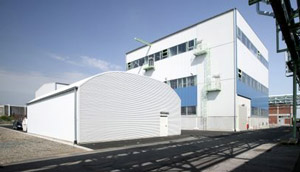CLARIANT
Capacity for non-halogenated flame retardants to be doubled / More environmentally friendly
 Phase 1 of the capacity expansion for flame retardants has already begun with the optimisation of the plant in Germany. In phase 2, capacity is set to be doubled with the erection of a second plant at the same site (Photo: Clariant) |
Swiss speciality chemicals producer Clariant (Muttenz; www.clariant.com) plans to double capacity for its “Exolit” OP non-halogenated flame retardants by 2012 to meet what it says is a “significant surge in demand” from the E&E sector for safer and more environmentally compatible products. In a first phase, the plant at Knapsack, near Cologne / Germany, which started up in 2004, will bring additional capacity on stream. A new industrial-scale facility is due to be completed by mid-2011. If forecasts for continued demand growth prove reliable, Clariant said it will “explore further opportunities to extend capacity from 2014 onwards.”
The Swiss group regards itself as a global market leader in non-halogenated flame retardants. Its Exolit OP portfolio is used to flame-retard such thermoplastics as polyamides and polyesters in applications such as switches, connectors, computer fans and structural parts. Additional applications are flame retardants for thermoset resins for new cable sheathing and insulation based on thermoplastic elastomers. “In recent years, the environmental and safety consciousness of our customers has increased significantly, leading to an unprecedented demand” for the flame retardants, Michael Grosskopf, head of the additives business unit, told journalists at K 2010. “Interviews with customers have indicated they will be as much as tripling their requirements over the next five years,” he added.
Clariant’s product range is said to enable customers to comply with new environmental legislation such as the ROHS regulations governing hazardous substance content in E&E equipment and the handling and recycling of waste (the EU’s WEEE directive). Other geographical regions, including the US and Canada, are planning to phase out or restrict certain brominated flame retardants, the group points out. Clariant says its flame retardants already comply with the new rules as they are non-halogenated, contain no red phosphorous or heavy metals, have a low impact on final product properties and do not produce corrosive smoke. The group also notes that Exolit OP contains “none of the hazardous substances covered by ROHS legislation.”
Safety and ecology aspects of the Swiss chemical producer’s masterbatch and pigments portfolios are also spotlighted in its “Power Your Performance” exhibit at K 2010. Clariant is showing new masterbatches and compounds for the medical and pharmaceutical sectors as well as efficiency enhancing processing aids in hall 8A, booth J11.
The Swiss group regards itself as a global market leader in non-halogenated flame retardants. Its Exolit OP portfolio is used to flame-retard such thermoplastics as polyamides and polyesters in applications such as switches, connectors, computer fans and structural parts. Additional applications are flame retardants for thermoset resins for new cable sheathing and insulation based on thermoplastic elastomers. “In recent years, the environmental and safety consciousness of our customers has increased significantly, leading to an unprecedented demand” for the flame retardants, Michael Grosskopf, head of the additives business unit, told journalists at K 2010. “Interviews with customers have indicated they will be as much as tripling their requirements over the next five years,” he added.
Clariant’s product range is said to enable customers to comply with new environmental legislation such as the ROHS regulations governing hazardous substance content in E&E equipment and the handling and recycling of waste (the EU’s WEEE directive). Other geographical regions, including the US and Canada, are planning to phase out or restrict certain brominated flame retardants, the group points out. Clariant says its flame retardants already comply with the new rules as they are non-halogenated, contain no red phosphorous or heavy metals, have a low impact on final product properties and do not produce corrosive smoke. The group also notes that Exolit OP contains “none of the hazardous substances covered by ROHS legislation.”
Safety and ecology aspects of the Swiss chemical producer’s masterbatch and pigments portfolios are also spotlighted in its “Power Your Performance” exhibit at K 2010. Clariant is showing new masterbatches and compounds for the medical and pharmaceutical sectors as well as efficiency enhancing processing aids in hall 8A, booth J11.
01.11.2010 Plasteurope.com [217647-0]
Published on 01.11.2010

 German version of this article...
German version of this article...